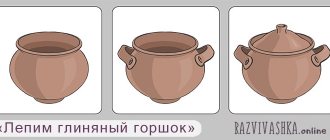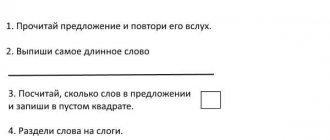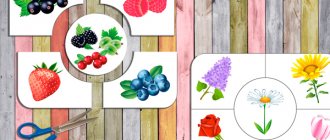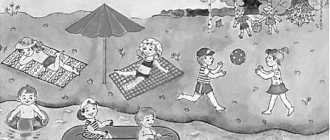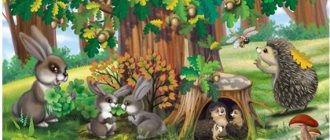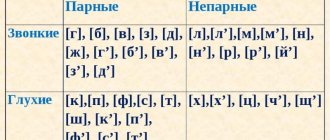Compiling a story based on a series of plot paintings.
https://www.liveinternet.ru/users/4619293/post246201328/
A series of story paintings designed for children to independently compose stories. Balloon. The adult asks the child to arrange the story pictures in a logical sequence, answer the questions with complete answers and compose a story independently
1. Answer the questions: Who lost the balloon and where? Who found the ball on the field? What kind of mouse was he and what was his name? What was the mouse doing on the field? What did the mouse do with the ball? How did the ball game end? Come up with a continuation of this story. 2. Write a story. Sample story "Balloon". The story is not read to the child, but can be used as an aid in case of difficulties in composing a children's original story. The girls picked cornflowers in the field and lost a balloon. The little mouse Mitka was running around the field. He was looking for sweet grains of oats, but instead of them he found a balloon in the grass. Mitka began to inflate the balloon. He blew and blew, and the ball became bigger and bigger until it turned into a huge red ball. A breeze blew, picked up Mitka with the ball and carried him over the field. House for a caterpillar. The adult asks the child to arrange the story pictures in a logical sequence, answer the questions with complete answers, and compose a story independently.
1. Answer the questions: Who are we going to write a story about? Tell me, what was the caterpillar like and what was its name? What did the caterpillar do in the summer? Where did the caterpillar crawl one day? What did you see there? What did the caterpillar do with the apple? Why did the caterpillar decide to stay in the apple? What did the caterpillar make in its new home? 2. Write a story. Sample story "House for the Caterpillar." The story is not read to the child, but can be used as an aid in case of difficulties in composing a children's original story. Once upon a time there lived a young, green caterpillar. Her name was Nastya. She lived well in the summer: she climbed trees, feasted on leaves, and basked in the sun. But the caterpillar didn’t have a house and she dreamed of finding one. Once a caterpillar crawled onto an apple tree. She saw a big red apple and started gnawing on it. The apple was so tasty that the caterpillar did not notice how it had gnawed right through it. The caterpillar Nastya decided to stay and live in the apple. She felt warm and comfortable there. Soon the caterpillar made a window and a door in its home. It turned out to be a wonderful house. New Year's preparations. The adult asks the child to arrange the story pictures in a logical sequence, answer the questions with complete answers, and compose a story independently.
1. Answer the questions: What holiday was approaching? Who do you think bought the Christmas tree and put it in the room? Tell me what the tree was like. Who came to decorate the Christmas tree? Come up with names for the children. How did the children decorate the Christmas tree? Why did they bring a ladder into the room? What did the girl attach to the top of the spruce tree? Where did the children put the toy Santa Claus? 2. Write a story. Sample story "New Year's Preparations." The story is not read to the child, but can be used as an aid in case of difficulties in composing a children's original story. The New Year holiday was approaching. Dad bought a tall, fluffy, green Christmas tree and put it in the hall. Pavel and Lena decided to decorate the Christmas tree. Pavel took out a box of Christmas tree decorations. Children hung flags and colorful toys on the Christmas tree. Lena could not reach the top of the spruce tree and asked Pavel to bring a ladder. When Pavel installed the ladder near the spruce tree, Lena attached a gold star to the top of the spruce tree. While Lena was admiring the decorated Christmas tree, Pavel ran to the pantry and brought a box with a toy Santa Claus. The children put Santa Claus under the tree and ran away from the hall happy. Today parents will take their children to the store to choose new costumes for the New Year's carnival. Bad walk. The adult asks the child to arrange the story pictures in a logical sequence, answer the questions with complete answers, and compose a story independently.
1. Answer the questions: Name who you see in the picture. Come up with a name for the boy and a nickname for the dog. Where was the boy walking with his dog? What did the dog see and where did it run? Who flew out of the bright flower? What was the little bee doing in the flower? Why did the bee bite the dog? What happened to the dog after the bee sting? Tell me how the boy helped his dog? 2. Write a story. Sample story “A Bad Walk.” The story is not read to the child, but can be used as an aid in case of difficulties in composing a children's original story. Stas and the dog Soyka were walking along the alley of the park. The jay saw a bright flower and ran to smell it. The dog touched the flower with its nose and it swayed. A small bee flew out of the flower. She was collecting sweet nectar. The bee got angry and bit the dog on the nose. The dog's nose was swollen and tears flowed from his eyes. The jay lowered its tail. Stas became worried. He took a bandage out of his bag and covered the dog’s nose with it. The pain has calmed down. The dog licked Stas on the cheek and wagged its tail. The friends hurried home. How a mouse painted a fence. The adult asks the child to arrange the story pictures in a logical sequence, answer the questions with complete answers, and compose a story independently.
1. Answer the questions: Come up with a nickname for the mouse you will talk about in the story. What did the little mouse decide to do on his day off? What did the mouse buy in the store? Tell me what color the paint was in the buckets. What paint did the mouse use to paint the fence? What color paints did the mouse use to paint flowers and leaves on the fence? Come up with a continuation of this story. 2. Write a story. Sample story “How a mouse painted a fence.” The story is not read to the child, but can be used as an aid in case of difficulties in composing a children's original story. On his day off, the mouse Proshka decided to paint the fence near his house. In the morning, Proshka went to the store and bought three buckets of paint from the store. I opened it and saw: in one bucket there was red paint, in the other there was orange paint, and in the third bucket there was green paint. The mouse Prosha took a brush and began to paint the fence with orange paint. When the fence was painted, the mouse dipped a brush in red paint and painted flowers. Prosha painted the leaves with green paint. When the work was done, the mouse's friends came to visit him to look at the new fence. Duckling and Chicken. The adult asks the child to arrange the story pictures in a logical sequence, answer the questions with complete answers, and compose a story independently.
1. Answer the questions: Come up with nicknames for the duckling and the chicken. What time of year is shown in the pictures? Where do you think the duckling and the chicken went? Tell us how your friends crossed the river: Why didn’t the chicken go into the water? How did the duckling help the chicken swim to the other side? How did this story end? 2. Write a story. Sample story "The Duckling and the Chick". The story is not read to the child, but can be used as an aid in case of difficulties in composing a children's original story. On a summer day, Kuzya the duckling and Tsypa the chicken went to visit the turkey. The little turkey lived with his father, a turkey, and his mother, a turkey, on the other side of the river. Kuzya the duckling and Tsypa the chicken approached the river. Kuzya plopped into the water and swam. Chick didn't go into the water. Chickens can't swim. Then Kuzya the duckling grabbed a green water lily leaf and put Tsypa on it. The chicken swam on a leaf, and the duckling pushed him from behind. Soon the friends crossed to the other side and met the turkey. Good fishing. The adult asks the child to arrange the story pictures in a logical sequence, answer the questions with complete answers, and compose a story independently.
1. Answer the questions: Who went fishing one summer? Come up with nicknames for the cat and dog. What did your friends take with them? Where did the friends go fishing? What do you think the cat started screaming when he saw that the float went under the water? Where did the cat throw the caught fish? Why did the cat decide to steal the fish that the dog caught? Tell me how the dog managed to catch the second fish. Do you think the cat and the dog still go fishing together? 2. Write a story. Sample story “Good Fishing”. The story is not read to the child, but can be used as an aid in case of difficulties in composing a children's original story. One summer, the cat Timofey and the dog Polkan went fishing. The cat took the bucket, and the dog took the fishing rod. They sat down on the bank of the river and began to fish. The float went under water. Timofey began to shout loudly: “Fish, fish, pull, pull.” Polkan pulled out the fish, and the cat threw it into the bucket. The dog threw the fishing rod into the water for the second time, but this time he caught an old boot. Seeing the boot, Timofey decided not to share the fish with Polkan. The cat quickly picked up the bucket and ran home for lunch. And Polkan poured water out of his boot, and there was another fish there. Since then, the dog and cat have not gone fishing together. Resourceful little mouse. The adult asks the child to arrange the story pictures in a logical sequence, answer the questions with complete answers, and compose a story independently.
1. Answer the questions: Come up with a name for the girl, nicknames for the cat, and the mouse. Tell me who lived in the girl’s house. What did the girl pour into the cat's bowl? What did the cat do? Where did the mouse run out from and what did he see in the cat's bowl? What did the mouse do to drink milk? What was the cat surprised when she woke up? Come up with a continuation of this story. 2. Write a story. Sample story "The Resourceful Mouse". The story is not read to the child, but can be used as an aid in case of difficulties in composing a children's original story. Natasha poured milk into a bowl for the cat Cherry. The cat lapped a little milk, put her ears on the pillow and fell asleep. At this time, the mouse Tishka ran out from behind the closet. He looked around and saw milk in the cat's bowl. The mouse wanted milk. He climbed onto a chair and pulled a long pasta out of the box. The mouse Tishka quietly crept up to the bowl, dipped the pasta in the milk and drank it. The cat Cherry heard the noise, jumped up and saw an empty bowl. The cat was surprised, and the mouse ran back behind the closet. How a crow grew peas.
The adult asks the child to arrange the story pictures in a logical sequence, answer the questions with complete answers, and compose a story independently. 1. Answer the questions: What time of year do you think the cockerel walked across the field? What did the cockerel bring home? Who noticed the cockerel? What did the crow do to eat the peas? Why didn't the crow eat all the peas? How did the bird sow the pea seeds in the ground? What appeared from the ground after the rain? When did the pea pods appear on the plants? Why was the crow happy? 2. Write a story. Sample story “How a Crow Grew Peas.” The story is not read to the child, but can be used as an aid in case of difficulties in composing a children's original story. In early spring, a cockerel walked across a field and carried a heavy bag of peas over his shoulders. The cockerel noticed the crow. She poked her beak into the bag and tore off the patch. Peas fell out of the bag. The crow began to feast on sweet peas, and when it was full, it decided to grow its own crop. The bird trampled several peas into the ground with its paws. Rain is coming. Very soon young pea shoots appeared from the ground. In mid-summer, tight pods with large peas inside appeared on the branches. The crow looked at her plants and rejoiced at the rich harvest of peas that she managed to grow.
Consultation for educators “Teaching children to tell stories from a picture”
Consultation for educators
Topic: “Teaching children storytelling from a picture (senior group)”
Authors: Elizaveta Sergeevna Kazachkova, teacher
Dvoretskaya Elena Arkadyevna, teacher
Municipal budgetary preschool educational institution
“Kindergarten No. 62 “Rodnichok” combined type”, Severodvinsk
Among the many skills that need to be developed in preschool children, the skills of coherent speech deserve special attention. They are of decisive importance, since the further development of the child and his acquisition of educational knowledge at school depend on the degree of their formation. In the methodology of speech development of preschool children, according to researchers O.I. Solovyova, F.A. Sokhina, E.I. Tikheeva and others, the use of paintings plays a leading role. A picture in its various forms (subject, subject, photograph, illustration, reproduction, filmstrip, drawing), and the subject in particular, when used skillfully, allows you to stimulate all aspects of a child’s speech activity.
Let's look at interesting (creative) techniques for teaching storytelling from a picture in the older group step by step:
1. “Determining the composition of the picture.” To encourage children to identify and name objects in the picture, the “spyglass” technique is used. Rule: point the telescope at one object and name it. To determine the details of one object, the techniques “Auction”, “Hunt for Details”, “Who is the Most Attentive”, etc. are used. These games are aimed at activating the attention of children. Children model identified objects using diagrams, letters, pictures, colors and other means of designation. To do this, use a board or sheet of paper on which the models are arranged in a similar way to the composition of a painting.
2. “Establishing relationships between objects in the picture.” The following creative tasks are offered: the “Unite” wizard came and combined two objects (the teacher points to two objects). The wizard asks to explain why he did this. Example: games with the picture “Cat with kittens”. “Looking for friends” - find objects that are related to each other by mutual location. Example: “The kittens are friends with each other because they are children of the same mother - cats and love to play together.” “Looking for enemies” - find objects that are “not friends” with each other. Example: “The balls are not friends with the basket because they rolled out of it and don’t want to be there.” Note: assessing the relationships between objects is subjective.
3. “Description based on the possible perception of objects in the picture by different senses.” The technique of “entering the picture”: the teacher encourages children to describe possible sensations and invites them to listen more carefully, inhale smells, taste, touch with their hands, etc. Creative tasks are given.
